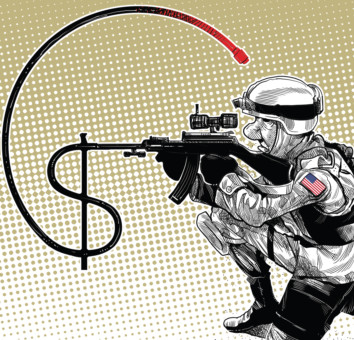
Rhetoric about nuclear weapons is heating up between Washington and Moscow, but there is no need to reinstate the foolish and wasteful arms race that dominated the Cold War period.
For one reason, the security challenges have changed.
Having 1,500 or more deployed US nuclear warheads on land or sea-based intercontinental ballistic missiles (ICBMs) or strategic aircraft with nuclear bombs or missiles, will not help a US president defeat terrorists or deal with proxy wars somewhere in the world — or even protect American assets in the new confrontational arenas of space and cyberspace.
There also are the astronomical costs for modernising not just the current triad of delivery systems — the strategic submarines, bombers and land-based ICBMs — but also continuing the life-extension programmes for the nuclear stockpile and upgrading the nuclear weapons-building complex itself.
US Deputy Defence Secretary Robert Work told the House Armed Services Committee last Thursday that the cost for all that modernisation would average $18 billion (Dh66.2 billion) a year from 2021 through 2035 — or $252 billion over that 14-year period. That annual average is nearly double the proposed nuclear weapons spending for next year and would mean 7 per cent of the entire Defence Department budget would be devoted in those out years just to the nuclear weapons program, up from around 3 per cent today.
“We’ll start replacing our Trident boats (strategic submarines at about $6.6 billion each) first. Then will come ... the bomber in the mid-20s (at $550 million each). And then will come the ground-based strategic deterrent ... in 2030 (at an unexplained price),” Work told the committee. “Carrying out this plan is going to be a very expensive proposition and we recognise that,” Work said, adding that it “will require very, very hard choices and will impact the other parts of the defence portfolio, particularly our conventional mission capability”. He also warned that these “20-year cost estimates are uncertain”.
The real question now should be why does the United States need that many new delivery systems and that many deployed nuclear warheads and bombs for the coming decades?
Let us pause for a moment and listen to the explanations given to Congress last week by Pentagon officials.
Work told the committee: “The only existential threat to our nation is a nuclear attack ... The one step down is preventing a catastrophic attack, which we believe would be one or two nuclear weapons being fired at the continental United States or blowing up in the continental United States.”
He talked about “Russian military doctrine that sometimes is described as ‘escalate to de-escalate,’ “which apparently means that Moscow would threaten to use or actually use a few nuclear weapons in a situation where it was losing to larger conventional forces. The threat or use of nuclear weapons would thereby get Russia’s enemy to hold up or withdraw.
“Anybody who looks at the way the international environment is moving, especially the way that Russia has been describing its nuclear deterrent posture, has to say: Nuclear weapons remain the most important mission we have,” Work said.
This, however, is Cold War talk.
Admiral James Winnefeld Jr., vice-chairman of the Joint Chiefs-of-Staff, was asked at last Thursday’s hearing about the Russians modernising their nuclear weapons systems. He responded that his major concern with Moscow’s programme was its shift to mobile, land-based ICBMs. Why? Because, he said, they “would be hard for us to hit in a first strike”. That would happen only if the time came when the US would want preemptively to wipe out Russia’s nuclear forces, before Moscow attacked US — an extremely doubtful scenario, but Cold War first-strike fears led to the building of tens of thousands of warheads.
As for the rest of Russia’s nuclear forces, Winnefeld testified that “their bomber leg is not as good as ours” and “their submarine-launched ballistic missile force, even with their improvements, is not as good as ours”. Why not reduce US forces? Winnefeld gave the traditional post-Cold War reply: “We still believe that any reductions in weapons must be done in concert with our potential antagonists, because unilateral gestures of goodwill have little standing with authoritarian regimes.”
Meanwhile, each US commander justifies continuing his own role in the triad. “If we look at the world environment today, it’s more dangerous than the Cold War and more unpredictable, and the ICBM force is as valid today as it was in the 1960s,” Air Force Major General Jack Weinstein, commander of the 20th Air Force, told the House committee last Thursday.
One of the new Ohio-class strategic submarines “will be in the water through approximately 2084”, said Vice-Admiral Terry Benedict, director of the Navy’s strategic systems programmes. “As we try and project out the threats through that time frame, the major focus ... was to ensure that we don’t find ourselves surprised in the future.”
The bomber fleet “is the most flexible and the most visible part of the triad. That’s what the bomber fleet offers. And I think from a flexibility standpoint, there’s not a lot of argument there,” were the words of Air Force Major General Richard Clark, commander of the 8th Air Force.
And to any unilateral reduction, Work supplied an old answer: “This is not a time for us to say that nuclear weapons are useless.”
I am not saying nuclear weapons are useless. I am suggesting the US does not need a nuclear force large enough to survive a decapitating first strike because there is no such threat — the idea of a Soviet first strike was a myth, but nonetheless it led to the Cold War nuclear arms race. Let us not do it again.
— Washington Post








